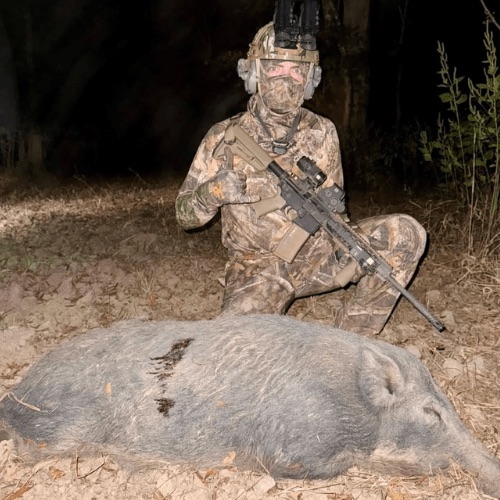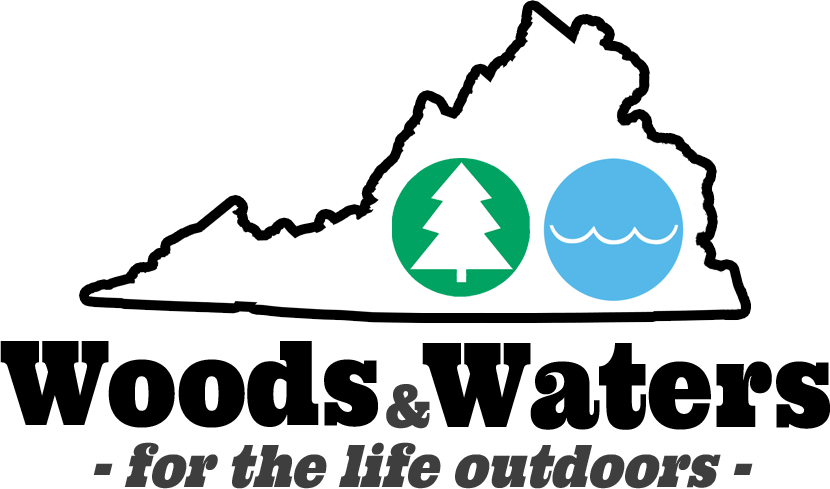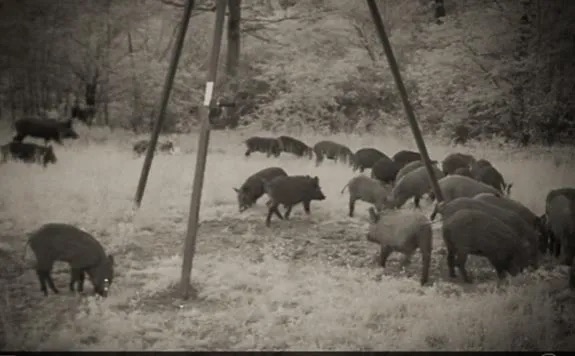Hogs After Dark: The Rise of Thermal Hog Hunting in Texas
Thermal hog hunting has quickly become one of the most sought-after hunting experiences in the Lone Star State, and for good reason.
It combines the excitement of using advanced technology, the nonstop action of hog hunting, and the year-round opportunity to hunt one of North America’s most destructive invasive species.
The hard truth is that Texas is home to millions of feral hogs that cause endless damage to farmland, disrupt native wildlife, and cause significant economic loss every year. To combat the problem, landowners have opened their gates to hunters using cutting-edge tools like thermal scopes, night-vision optics, and suppressed rifles.
The result? A fast-paced, high-adrenaline hunt that challenges even the most experienced sportsmen.
Now, unlike traditional big-game hunts, thermal hog hunting happens under the cover of darkness, when hogs are most active. Hunters will scan fields and creek bottoms with thermal imagers to locate “sounders”, groups of wild pigs moving through the night.
Once spotted, the stalk begins, offering a style of hunting that feels both tactical and primal.
Why Texas Holds This Hunt Apart
Texas is well known for its hog hunting, and it is widely accepted that Texas is serious hog country. With feral swine populations estimated in the millions and a statewide reputation for destruction and mischief, the state has turned the challenge into an opportunity.
As you might imagine, on private land in Texas, there’s no closed season and no bag limits for feral hogs. With that being said, hogs are smarter than you think, as they’ve adapted to hunters, sensors, and even daylight pressure. Many of the largest sounders are now active at night, where they feel safest.
What that means for a hunter from Virginia (or anywhere else) is simple:
This hunt will undoubtedly find its way to the top of your hunting bucket list.
Gear & Tech: Night Hunting Evolved
Thinking of bringing your daytime rifle? You’ll likely need more. A daytime optic? Not going to cut it.
On a Texas thermal hog hunt, your load-out should be entirely chosen to optimize your shot for the darkness.
Thermal Optics
Handheld scanners and rifle-mounted thermal scopes are not optional when hunting at night.
In the darkness, a brush line that looks empty becomes a highway of heat-signatures. The better the resolution and refresh rate on your optic, the smoother that scan becomes. Experts agree that full-resolution models (640×480 or better, 60 Hz refresh) deliver the crisp, thermal images that will help you make your shot, even in total darkness.
Suppressed Semi-Autos & Calibers
Most outfits provide or allow high-power rifles in cartridges like .308, .300 BLK, 6.8 SPC, or similar, often paired with suppressors to keep noise low and follow-up shots quicker. If you elect to use a Texas hog hunting outfitter, they will almost always have gear recommendations when it comes to hunting hogs at night.
Tripods, Headsets & Comm Systems
Due to the preference for so many hog hunters to use silencers for silent shots, hunters often use tripods or shooting sticks to help keep their shots on target, along with headsets for guide communication and extra batteries (thermal gear eats power).
For example, some guides recommend using helmet-mounted IR plus thermal scopes to stealth-stalk sounders on foot.
Prep & Training
A serious thermal hunt starts with orientation and understanding of the hunt. A lot of outfits will recommend a “safety course with equipment familiarisation” before heading out, especially for novice hunters. Comfort in darkness, optics, and movement matter; this is not a run-of-the-mill daylight hunt.
Tactics by the Hour: How the Hunt Unfolds
Diving into the exact hour of the evening, a nighttime hog hunt evolves as the night gets darker.
Scouting & Setup (Just after sundown)
Since most nighttime hog hunts in Texas are hosted by outfitters, you will first meet your guide at the lodge, receive and set up your gear, and get a hunt briefing. You then make your way out to the field’s edge, crop transition zone, or bean-field edge. Guides know very well where hogs move at night on their land, whether it be near water sources, transition edges, or root fields.
The Hunt (Night hours)
Once the lights go out, the thermals go on.
The guide will most likely have their own thermal sights, scanning the field for clusters of heat. Once movements are targeted, appearing as small glows shifting behind a dirt berm, and you identify a group of hogs, the hunt is on.
Your guide will point you in the right direction to move into position. Most commonly on foot, low and quiet, you’ll get within 50-100 yards of your target. Some hunts even push within 20-30 yards if conditions allow, which is where you take your shots.
Follow-through and Recovery
After taking down a hog, the recovery process begins.
The guide will act as a spotter to confirm your hits, wait for silence, then move in to mark the hog. If you will be field-dressing the hog, you will end up dragging the hog to a clear area, processing the meat under a headlamp.
And yes, you or your guide will have a cooler to pack out or a processor lined up at the lodge.

The Emotional Pulse: Why It’s More Than a Shot
Try the standard hunt one more time, then stack this next to it. The difference in the two hunts is “night and day”.
You’ve sat sun-up to sun-down. You’ve climbed tree stands. You’ve called. You’ve waited. That’s good. But this? This is reactive. This is real-time adrenaline.
Picture this:
A completely quiet field. The only sound is the night wind and the crackle over your headset. Then your thermal glows to life. You see a dozen whiteish-yellow points drifting across a dark field. You tell your buddies. You move. You set. You fire. Then for a moment, silence. A rush. Then more movement. Many hunters say it changes their entire hunting outlook and has them coming back year after year.
And there’s a story behind it. The hogs you just took down were tearing up someone’s fence, destroying crop fields, and displacing native wildlife. You’re not just hunting for fun, you’re hunting to make an impact. That duality, the thrill and purpose behind the hunt, is what lifts this experience into bucket-list territory.
Planning Your Hunt: Practical but Purposeful
As any hunter knows very well, the success of any type of hunt depends on the level or preparation.
When to Go
While thermal hunts run year-round, there are smarter, more effective windows.
Fall (September–November) sees hogs drawn to newly harvested fields, dropping nuts, and cooler nights that keep them moving. But summer nights bring heat-sting, and winter nights bring rugged cold. Choose what fits the type of hunt you’re going after.
Outfitter Checklist
It can be a huge plus to choose a guide service that includes the following in its package:
- Thermal gear, rifles & suppressors (if you do not have your own)
- Lodging or lodging advice
- Unlimited hog opportunities (many Texas hunts have no bag limits)
- Well-instructed safety briefings
For instance, look for an outfit that offers “no hidden fees, no trophy fees, no limits on hogs” for their thermal night hunts.
What To Bring
Boots that can handle brush and muddy terrain are a must-have, as well as comfortable but quiet clothing. You will also need a headlamp with a red filter and extra batteries. Beyond that, it’s always best to have some form of ear and eye protection.
Lastly, you must come equipped mentally to be ready for a late night, for the unexpected, and for a completely different hunting rhythm.
Legal & Ethical Notes
On private land in Texas, feral hogs are classified as invasive species and can be hunted year-round, and on many properties, a license is not even required (with landowner permission).
However, it is important to respect property, follow hunting outfitter rules, and ensure safe target identification. Even at night, you must know what’s beyond your shot.
Why This Belongs on Your Bucket List
Every hunter reaches a moment where the usual hunts aren’t a tradition, but they are looking for the next exciting, new experience. You’ve climbed stands, tracked game, and hit limits. You’re good. But now you want something different. You want electric. You want something you’ll replay in your mind for years.
This Texas thermal hog hunt delivers that to the highest degree. Every sense is heightened as you’re tucked away in the dark of the night, with a thermal scope, watching the glow, and enjoying the hunt.
You will most certainly have an amazing story to tell, and that story becomes more than a hunt; it becomes your own sort of legend.
For any hunter looking to check a true bucket-list box: this is it.



